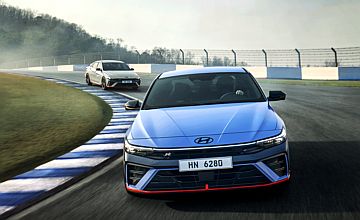OptionsCar reviews - Hyundai - i30 - Sedan NHyundai modelsOverviewWe like One of the most characterful cars for the money, ridiculous fun, revised drive experience is better than before, still feels plush inside, spacious cabin, still comes with a manual ‘box Room for improvement No ANCAP rating, some annoying safety features, red exterior highlights are garish, no adaptive cruise, missing items compared to KDM model New looks, higher price and same nature for the facelifted i30 Sedan N1 Mar 2024 Overview
FACELIFT? No, the updated Hyundai i30 Sedan N has seen more than just some cosmetic adjustments… some of which you might find a bit questionable.
But beneath the new red stripes and revised front and rear designs, there’s a reworked suspension damper tune, updated steering parts, new chassis components, a stiffer frame, extra brake hose insulation for fade resistance, redone stability control tuning and even redesigned engine mounts to lessen axle-tramp from a standstill.
Those changes will no doubt appease the enthusiast, but for the daily driver there are other spec’ adjustments that improve the value equation somewhat, considering the new model is $1800 more expensive at $52,000 +ORCs. The list price applies to either the six-speed manual and eight-speed dual-clutch auto, and the only options are premium paint ($595) and a sunroof ($2000).
Familiar from the last i30 Sedan N is a 2.0-litre turbo-petrol four-cylinder engine, with peak outputs of 206kW (at 6000rpm) and 392Nm (at 2100-4700rpm). It still has multiple N driving modes including configurability to the steering, suspension and powertrain response, and there’s N Grin Shift auto rev matching, too.
The official combined cycle fuel efficiency number is 8.5L/100km for the manual, and 8.3L/100km for the auto models – which is slightly higher than the pre-facelift versions. You won’t see anything near that if you take it to the track, though.
There’s a five-year/unlimited kilometre warranty for the car, and enthusiasts, take note – Hyundai covers the vehicle for track use, but not racing (see the terms and conditions before you buy) and there’s also a lifetime capped-price service schedule which, if you maintain with the brand, includes lifetime roadside assistance.
Unlike some other models in the standard i30 Sedan range, the Sedan N requires maintenance every 12 months/10,000km, and the capped-price servicing plan over the first five years/50,000km averages out at $359 per visit.
The i30 Sedan N is considerably bigger than the N hatch, stretching 4710mm (2720mm wheelbase), with a large boot capacity of 474 litres, not to mention a space-saver spare wheel under the boot floor. The standard sedans feature a more practical space, though, as the N has a stiffening bar positioned behind the rear seatbacks that means your load-through capability is muted.
N models get some specific interior finishing to set them apart from cheaper versions with leather appointed trim and sports front seats - but oddly, the driver’s seat (which features electric adjustment and memory settings) isn’t as easy to position as in the lower spec’ versions.
There’s also a black N badge on the steering wheel, red stitching, and N mode buttons on the wheel. The cabin has twin 10.25-inch displays, the media screen incorporates Apple CarPlay and Android Auto, but also has built-in satnav, and an eight-speaker Bose sound system.
A six-foot adult can slide in behind a similarly sized driver with a bit of space to spare, plus for family buyers there are bottle holders, directional air-vents, two new USB-C charge ports, and the expected ISOFIX points in the window seats, and three top-tether points.
Driving impressions
The most impressive thing about the revisions to the i30 Sedan N is that it still retains its “hooligan” and “corner rascal” characteristics, but it’s now more liveable in day to day scenarios.
The steering is smidge more respectful, too. Previously it was great, but it just feels a touch more urban friendly. In more demanding situations you still get a quick point-to-point and point-and-shoot experience, with fast responses, and a good amount of feel through the wheel.
There’s a locking front differential which you can feel working when you’re really up it, as it helps to get a bit more balance out of the bends as you power out. It’s not devoid of torque steer, but is more limited than you might expect from a front-wheel drive car pumping out these kinds of figures.
And thankfully, the throttle-down response has been improved with those new engine mounts, which notably reduce the amount of axle-tramp when you flatten it from a stop (or even in second-gear, in the pre-facelift).
The engine is a corker, too. It’s not “quick-EV” fast with a 0-100km/h of 5.3 seconds, but it has far more character than any car at this price with a plug.
I drove both the six-speed manual with its hefty-feeling clutch (stallable in stop-start driving…. I even saw one of the racing driver instructors stall it), and the eight-speed wet dual-clutch auto. The latter is the pick for liveability, but the former is the fun one for the track-focused buyer.
The i30 Sedan N remains a terrific alternative to the Subaru WRX, and a far more affordable family car option than a Civic Type R or VW Golf R.
 Read more30th of January 2024  LDV eDeliver 7 electric van priced under $60KABN buyers treated to sub-$60,000 entry price for LDV’s eDeliver 7 mid-sized electric van |
OptionsClick to share
|
















Facebook Twitter Instagram